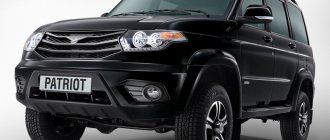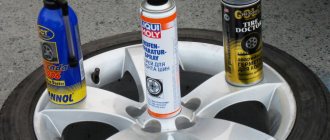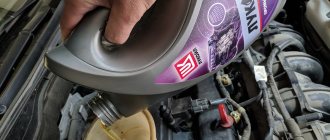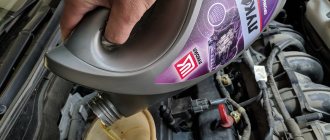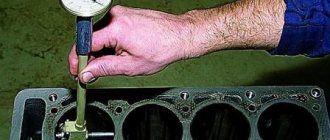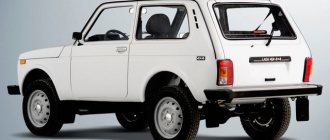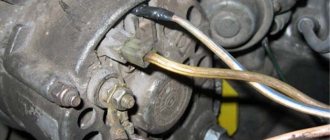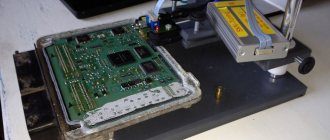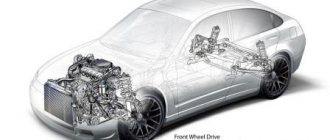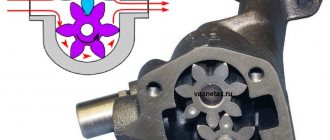Niva drive device
The chassis of the car is made on the principle of permanent all-wheel drive - torque from the power unit is transmitted to all 4 wheels. This scheme improves the performance of the car when driving in off-road conditions, while simultaneously reducing the load on transmission parts.
The Chevrolet Niva drive consists of the following components:
- Gearbox.
- Transfer case.
- A pair of drive and cardan shafts.
- Front and rear axle gearboxes.
The transfer case is designed to distribute torque between the drive axles of the vehicle. The car is equipped with a two-speed transfer case, which provides:
- stable running of the machine when driving at low speed and at high engine speeds;
- power distribution between drive axles, depending on road grip.
The differential is one of the most important elements of the transmission. Its main purpose is to distribute traction force, and, if necessary, ensure rotation of two consumers at different angular speeds. The Chevrolet Niva drive transmission has three differentials:
- One for each axle (interwheel) - enable the wheels of the same axle to rotate at different speeds.
- The third (interaxle action) - transmits power from the power unit to both axles of the vehicle. It also allows the shafts to operate at different angular speeds, depending on operating conditions, which significantly improves controllability.
A pair of cardan shafts (CV joint or cross design) provide connection between the transfer case and the drive axle gearboxes. Both car shafts have the same design - they are interchangeable.
How to use a transfer case with a range multiplier on a Niva 2121
The relatively complex scheme for distributing torque from the internal combustion engine to the wheels is explained by the universal purpose of the Niva 2121 - if used correctly, it can be used comfortably in the city and along muddy country roads. Such properties are ensured by the presence of a transfer case with a center differential lock, complementing a 4- or 5-speed manual transmission, depending on the year of manufacture.
The normal position for the RK handles, ensuring adequate behavior on the road of good quality:
- Front - away from you Back - towards you
The special operating mode of the transmission is switched on not long before the car begins to overcome an obstacle (rut, mud, ford or rise). The transition to the lowest row must be done while stopping. Returning to top gear is allowed on the go, although it causes problems for beginners due to the lack of the usual synchronizer.
It is somewhat more difficult to properly handle the forced manual locking of the center differential. On the contrary, it turns on when the car moves slightly (up to 20 km/h) due to misalignment of the grooves on the locking clutch, satellites and ring gear. To simplify turning the lever into the desired position, taking into account the Niva 2121 transfer case, pick up a small speed, then, shaking the steering wheel, pull the handle towards you.
Problems can also arise when disengaging the lockout, as the clutch teeth literally catch on the ring gear. Engage reverse and, rocking the steering wheel, push the lever away from you. This action is performed immediately after overcoming a difficult section in order to avoid overloading the gearbox. It is most effective to disable the differential together with the transition to lower stages.
Read news about the new Niva
- All-terrain vehicle fracture 4x4: photo of step-by-step assembly video of a trip on an all-terrain vehicle
- Homemade all-terrain vehicle on low-pressure tires (45 photos)
- Dismantling and assembling the gearbox Niva 2121, Niva 2131
- Nissan engine on a Niva – Replacing a Niva engine with a Japanese one
- FROST car air conditioners // Online store // Prices // Air conditioners for cars Lada VAZ, VolksWagen Polo, Daewoo Matiz
- Transfer case Niva VAZ - do-it-yourself repair and replacement
- Transfer case Niva 2121: principle of operation, repair
- Gearbox VAZ-21213 Lada Niva, VAZ-21214 Lada 4x4, diagram
The principle of operation of all-wheel drive on a Chevrolet Niva
In normal mode, the Chevrolet Niva operates in high gear with the differential unlocked. Torque is transmitted from the power unit, through the gearbox and intermediate shaft, to a two-stage transfer case gearbox. A center differential is installed in the transfer case housing. It links the front and rear axles, allowing them to rotate at different speeds, depending on road conditions and direction of travel.
How does all-wheel drive work on a Niva with a locked differential?
When all-wheel drive is engaged, both cardan shafts are secured with a locking clutch. This promotes uniform transmission of traction force to both axles of the vehicle. Due to this, the vehicle's cross-country ability increases, but controllability deteriorates.
Advice: It is not recommended to use the lock mode on roads with good grip, as this will lead to accelerated tire wear, increased load on transmission parts and components, and will also increase fuel consumption.
Nivov transmission units
The developed Niva transmission turned out to be so successful and efficient that it later became a prototype for the Vitara. This made the new model more adaptable to difficult roads. Niva transmission units can easily meet the requirements of any engine up to 2 liters, so if you want to upgrade, think about the fact that each car has its own capabilities. Many advantages are due precisely to the circuit and design of the transmission.
Niva transmission and its components:
- front-wheel drive;
- front axle;
- wheel grip;
- manual transmission;
- driveshaft (front);
- shaft (intermediate);
- transfer case;
- shift lever;
- center differential and locking lever;
- wheel differentials;
- driveshaft (rear);
- rear axle;
- rear drive.
The design implies the following states:
- unlocked differential;
- locked differential;
- low gear when engaged;
- neutral position;
- top gear engaged.
How to turn on all-wheel drive
Since the drive on the Niva is constantly all-wheel drive, the question of how to turn on the all-wheel drive on the Niva Chevrolet means how to turn on the center differential lock.
You need to use blocking in the following cases:
- when driving in difficult terrain where there is a danger of wheel slipping;
- when there is a lack of engine thrust;
- when driving on a road covered with snow or ice.
Important: Blocking is useless when the car is hung diagonally, when one wheel on different axles begins to slip. This is due to the design feature of the transmission. In this case, you need to act according to the situation - dig up or pour under the hanging wheels.
The main component of the axle locking mechanism is the transfer case. The transfer case is controlled by one six-position lever. The longitudinal stroke provides higher and lower gear rows. Transverse - responsible for locking the center differential. When the lever is in lock mode, a yellow icon lights up on the instrument panel. There are no synchronizers in the design of the transfer case, therefore, when you try to engage the speed range or lock, the gears clash tooth to tooth. To switch, you just need to move the car forward or backward and then everything will switch.
Niva transmission how to operate correctly: operating principle
The VAZ 2121, in other words, “Niva”, entered mass production in the 70s of the last century. This car belongs to the class of off-road passenger cars. In the history of the domestic automobile industry, Niva became the first car whose design used all-wheel drive. Let's take a closer look at the transmission device. This should be done in order to understand why, given its almost 40-year history, the Niva transmission differs from many other similar vehicles equipped with all-wheel drive and the ability to shift in the classical way or using a viscous coupling.
The transmission in the Niva family (2121, 2131) is designed in such a way that all-wheel drive is supplied to 4 wheels. Also characteristic is the presence of a center differential. The transmission includes a gearbox, a transfer mechanism, a pair of cardan shafts, and both axles. A characteristic feature of the 2131 model is its elongated body. Otherwise, the main similarities with the first model can be traced throughout. Torque is transmitted from the engine through the gearbox to the transfer case, and it, in turn, transmits torque to the axles.
Then it goes through the cardan shafts to the gearboxes. The front gearbox transmits torque to the wheels through the differential and constant velocity joints. Likewise for the rear, also protruding, driving wheels. It is precisely because the torque is distributed to 4 wheels simultaneously that the drive is called full drive. The designation is as follows – 4WD. Another domestic car, designed on a similar principle to the Niva, is the UAZ.
Differential
This mechanism is a kind of distributor of traction forces coming from the motor to the wheels. An important feature is that the latter have the ability to rotate at different speeds. The importance of having a differential mechanism is due to the fact that during turning maneuvers, the wheel located inside makes fewer revolutions when compared with the number of turns of the outer wheel.
In the absence of a differential mechanism, this would cause detrimental consequences, such as wear and damage, because the result would be the following: when turning, one wheel would be in a slip state, and the second would simply rub against the road surface. The design features of the Niva transmission provide for the presence of 3 differentials. They are located in each of the bridges and in the transfer mechanism.
When the car moves on a flat road and in a straight line with differentials, the traction force is divided equally between all 4 wheels. If there is insufficient adhesion of the wheels to the surface or slipping occurs, the differentials will redistribute the load on the slipping and sliding wheel so that the first receives more force, and the second, accordingly, less.
We have already mentioned UAZ. Despite many similarities, it should be understood that the VAZ’s all-wheel drive is made in the “pat-time” style. This means that when connected, the axes are firmly connected to each other, and rotation occurs at the same speeds. This device imposes some restrictions on the use of all-wheel drive - it can only be used in cases where road conditions allow slipping. In cases with hard asphalt roads and highways, it is recommended to switch the car to single-drive mode.
Differential locking
Sometimes you can come across a misconception about why a small handle is needed next to the shift lever on a Niva. Some car owners believe that it is needed to connect front-wheel drive. However, the front-wheel drive of this car is permanently connected. As is the rear one. Cars of the Niva family have permanent all-wheel drive. The handle actually serves to switch the operating modes of the differential of the transfer mechanism.
In the “forward” position, the differential operates as usual, but if you move it back, the differential is locked, and the forces from the motor are applied to the differentials of the axles, which makes the drive more rigid. It is worth noting that there are also special types of locks for front and rear axles.
In theory, when used in conditions where the car is stuck, it will be able to overcome the obstacle if there is sufficient traction on at least one wheel. In this case, it is better to lock the differential before overcoming an obstacle, but never after entering an area that is difficult to overcome. This application of locking will avoid wear and damage to the transmission.
A series of downshifts
You can often encounter the following type of misconception: switching the rear handle can increase the power characteristics of the motor. But this is not true. It serves to change the gear ratio between the engine and the wheels. By increasing it, the traction forces on the wheels will increase. There is also a reduction gear in the dispensing mechanism.
Customer Reviews
To make your choice easier, we suggest reading selected comments from the owners of the relevant cars. Perhaps it is after them that the solution will become obvious to you. Reviews about Chevrolet Niva:
– Gasoline consumption is better than that of the Shnivy when it was first produced. Easy to maintain, I don’t spend a lot on spare parts. The interior is wide, easy to climb in and accommodate a family. The seats seem comfortable, but after a forced march of 1000 km I could barely stand on my feet. The engine is very weak, and I also lack luggage space. Andrey, Belgorod.
– I already have my second Chevy. Traveled about 130,000 km. Model 2005. Holds up well, there were no serious damage. It rides very well over bumps and mud, but it drives better around the city, and it’s not so embarrassing to show off. Of the minuses, I can name the noise in the cabin and the squealing gearbox. Egor, Tver.
Lada Niva:
– I bought my Niva in 2012. Compared to the 1984 version, there is slight progress in the engine and power steering. Better placement of rear axle shock absorbers. In general, the assembly is sloppy: the seats are torn, the transfer case howls, there are all sorts of squeaks. The old Niva seemed better put together. But I like the look, it's antique. Ivan, Nizhny Novgorod.
– I bought a car with a trailer in 2021 for off-road trips and the mountains of the East. Excellent cross-country ability, over 5,000 kilometers it has never failed. Handling is confident, spare parts are relatively cheap. The interior does not creak yet; in frosty temperatures of -30 degrees it starts immediately. But there are also a lot of disadvantages. The steering wheel is not height adjustable, nor are the front seats. The transfer case kept squealing and squealing. There is no lighting for the glove compartment, and there is practically no interior either. Despite this, for its price the Niva is an excellent purchase, even with a trailer. I am pleased. Luda, 38 years old.
As a conclusion, we can say that both Niva are really worth each other. Each buyer is individual, he has his own circumstances, conditions and tastes. Let him choose a car based on them. Lada 4x4 feels great on trips out of town like fishing or hunting, it doesn’t require much, it is distinguished by its rough independence: nothing superfluous, just the minimum. The Chevrolet Niva is more comfortable inside, looks and behaves better in the city, where driving conditions are less difficult, but it will not be at all afraid of a sudden trip to the outback. Whatever your choice, don't let it disappoint!
Niva Chevrolet disabling the front axle
The Chevrolet Niva SUV is designed in such a way that it always has four-wheel drive. This means that in an attempt to get out of a pond or swamp, not two wheels, but all four will participate, which is why all-wheel drive is called 4x4. But those drivers who do not travel outside the city, and operate the car in the city and on the asphalt, do not always need the full drive function. What you need to know in order to be able to disable the front-wheel drive when it is not needed, as well as the main important points of its use. We will look at all this information in this material.
All-wheel drive features
Chevy Niva is an all-wheel drive SUV, which is intended for use primarily off-road. Off-road driving involves the use of the front axle. More precisely, the front and rear axles are constantly in operation, only the synchronization of their operation is controlled by the transfer case. If you turn off one bridge, fuel consumption will decrease. But if the Chevrolet Niva is driven on a road surface with a dry and hard surface, then is there no need to use front-wheel drive?
In addition, the use of the front axle entails an increase in fuel consumption of 2.5 liters per 100 km. Therefore, it is not recommended to use front-wheel drive unless necessary. If you disable the front axle on a Chevrolet Niva, you should avoid road surfaces or off-road areas where there is mud, snow or ice. If you plan to travel to such surfaces, then the bridge should be included in the work in advance.
Thus, the owner of a Niva Chevrolet SUV should know how to disable the front axle and when should it be done? But first, let’s look at what the drive disconnect mechanism on the Chevy Niva SUV is.
The block is designed to divert torque from the front cardan drive shaft, which actually entails physical disconnection of the front axle. Such a block was specially developed by Tolyatti engineers. The Niva Chevrolet car is not equipped with such a unit from the factory, so if desired, you can install it yourself. The block is a structure that is shown in the photo below.
The device is controlled directly from the interior of the SUV, using the transfer case control lever.
Disabling the front drive without this device is only possible by removing the front driveshaft, which is what most Shnivovodov actually do. Some craftsmen resort to removing the rear driveshaft, resulting in a front-wheel drive car.
Of course, operating a Chevrolet Niva SUV without one of the cardans is not prohibited, but this will negatively affect some elements of the car. In particular, the transfer case supports, output shaft bearings, and also the cardan itself are damaged.
In addition, if all-wheel drive is required, without a cardan, it will not be possible to use this function. Therefore, if you decide to disconnect the bridge, then you should do this using a device such as a disconnect unit.
As you can see, this block is a coupling that connects the front cardan in the transfer case with the gearbox. The shutdown unit is controlled from inside the Chevrolet Niva car using a lever located near the gearbox.
If you decide to install such a unit on your car, you should initially purchase it. The bridge disconnect unit is installed in the following order:
- The 5 nuts of the axle drive housing cover are unscrewed.
- The cover is dismantled together with the coupling and shaft.
- The bridge block is installed in place of the cover that was dismantled.
Before installation, you may encounter the problem of the coupling falling out. To install the coupling in place, it is necessary to turn it with the groove towards the flange. - The transfer case is being installed in its place.
- Check the transmission oil. If the level drops, it should be topped up.
The price for such a unit is about 6-7 thousand rubles, but its presence will always allow the driver to feel much more confident when driving off-road and save on fuel.
